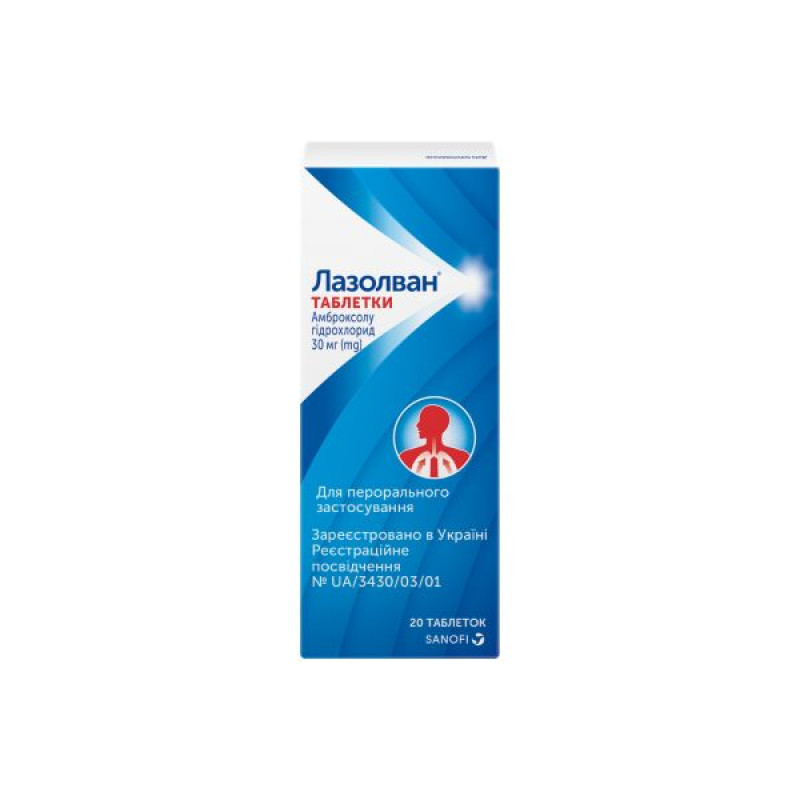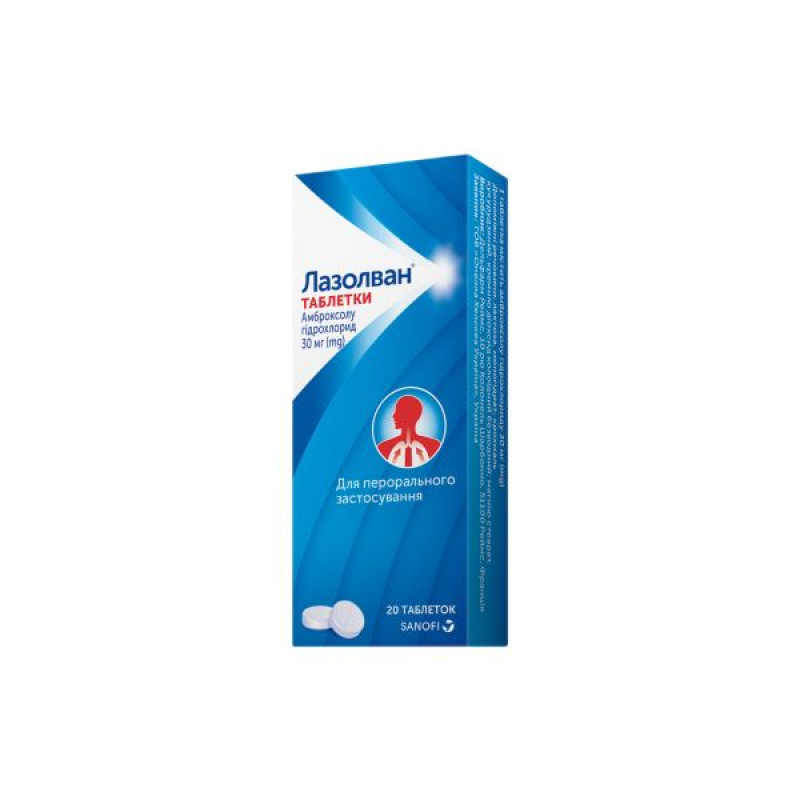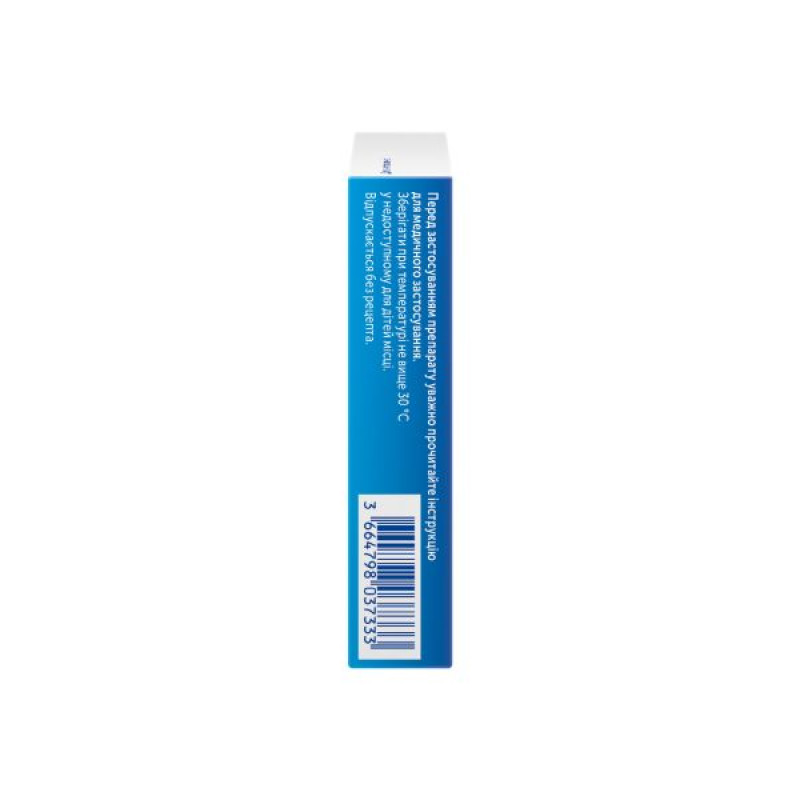Lasolvan tablets 30 mg No. 20

Instructions for Lasolvan tablets 30 mg No. 20
Composition
active ingredient: ambroxol hydrochloride;
1 tablet contains ambroxol hydrochloride 30 mg;
Excipients: lactose monohydrate; corn starch; colloidal anhydrous silica; magnesium stearate.
Dosage form
Pills.
Main physicochemical properties: round, white or slightly yellowish tablets, flat on both sides, with beveled edges; on one side of the tablet there is a notch and marking "67C" on both sides of the notch, on the other side of the tablet there is an embossed brand name.
Pharmacotherapeutic group
Medicines used for coughs and colds. Mucolytics. ATX code R05C B06.
Pharmacological properties
Pharmacodynamics
It has been preclinically proven that the active ingredient of the drug Lasolvan®, tablets, ‒ ambroxol hydrochloride ‒ increases the formation of the serous component of bronchial secretion. Ambroxol enhances the secretion of pulmonary surfactant by directly affecting the type II pneumocyte in the alveoli and Clara cells in the bronchioles, and also stimulates ciliary activity, as a result of which the viscosity of sputum decreases and its excretion improves (mucociliary clearance). Improvement of mucociliary clearance has been proven during clinical and pharmacological studies.
Increased production of serous secretions and increased mucociliary clearance facilitate expectoration and reduce coughing.
COPD patients treated with ambroxol hydrochloride 75 mg prolonged-release capsules for 6 months had a significant reduction in the number of exacerbations compared to placebo at the end of 2 months of treatment. Patients treated with ambroxol hydrochloride had significantly fewer days of illness and required fewer days of antibiotic therapy. They also had a statistically significant reduction in symptoms such as difficulty in expectoration, cough, dyspnea and wheezing compared to placebo.
The local anesthetic effect of ambroxol hydrochloride was observed in a rabbit eye model, which may be explained by its sodium channel blocking properties. In vitro studies have shown that ambroxol hydrochloride blocks neuronal sodium channels; binding was reversible and concentration-dependent.
Ambroxol hydrochloride has demonstrated anti-inflammatory effects in vitro. Thus, ambroxol hydrochloride significantly reduces the release of cytokines from mononuclear and polymorphonuclear blood cells and tissues.
Clinical trials involving patients with pharyngitis have shown a significant reduction in pain and redness in the throat when using the drug.
Due to the pharmacological properties of ambroxol, pain was quickly relieved during the treatment of upper respiratory tract diseases, which was observed during studies of the clinical efficacy of inhaled forms of ambroxol.
The use of ambroxol hydrochloride increases the concentration of antibiotics (amoxicillin, cefuroxime, erythromycin and doxycycline) in bronchopulmonary secretions and sputum. To date, no clinical significance has been identified for this fact.
Pharmacokinetics
Absorption: Absorption of ambroxol hydrochloride from oral immediate-release formulations is rapid and complete, with a linear dose dependence in the therapeutic range. Maximum plasma levels are reached after 1–2.5 hours with oral immediate-release formulations and on average after 6.5 hours with slow-release formulations.
The absolute bioavailability after taking a 30 mg tablet is 79%.
Distribution. When administered orally, the distribution of ambroxol hydrochloride from the blood to the tissues is rapid and pronounced, with the highest concentration of the active substance in the lungs. The expected volume of distribution when administered orally is 552 l. In the blood plasma in the therapeutic dose range, approximately 90% of the drug is bound to proteins.
Metabolism and elimination. Approximately 30% of the dose after oral administration is excreted as a result of presystemic metabolism. Ambroxol hydrochloride is metabolized mainly in the liver by glucuronidation and cleavage to dibromanthranilic acid (approximately 10% of the dose). Studies in human liver microsomes have shown that CYP3A4 is responsible for the metabolism of ambroxol hydrochloride to dibromanthranilic acid.
After 3 days of oral administration, about 6% of the dose is excreted in the urine in unchanged form, approximately 26% of the dose in conjugated form.
The plasma half-life is about 10 hours. Total clearance is about 660 ml/min. Renal clearance is about 8% of the total. After 5 days, about 83% of the total dose is excreted in the urine.
Pharmacokinetics in special patient groups. In patients with impaired liver function, the excretion of ambroxol hydrochloride is reduced, which results in a 1.3-2 times higher level in the blood plasma. Since the therapeutic range of ambroxol hydrochloride is quite wide, it is not necessary to change the dosage.
Age and gender have no clinically significant effect on the pharmacokinetics of ambroxol hydrochloride, therefore no dose adjustment is required.
Food intake does not affect the bioavailability of ambroxol hydrochloride.
Indication
Secretolytic therapy for acute and chronic bronchopulmonary diseases associated with disorders of bronchial secretion and impaired mucus movement.
Contraindication
Lasolvan® should not be used in patients with known hypersensitivity to ambroxol hydrochloride or other components of the drug.
Interaction with other medicinal products and other types of interactions
The simultaneous use of the drug Lasolvan®, tablets, and cough suppressants may lead to excessive mucus accumulation due to suppression of the cough reflex. Therefore, such a combination is possible only after a careful assessment by the doctor of the ratio of the expected benefit and the possible risk of use.
Application features
Severe skin reactions: erythema multiforme, Stevens-Johnson syndrome (SJS)/toxic epidermal necrolysis (TEN) and acute generalised exanthematous pustulosis (AGEP) have been reported in association with the use of ambroxol hydrochloride. If there are signs of progression of the skin rash (sometimes associated with blistering or mucosal involvement), ambroxol hydrochloride treatment should be discontinued immediately and medical advice should be sought.
Lasolvan® tablets contain 684 mg of lactose in the maximum recommended daily dose (120 mg). Patients with rare hereditary conditions of galactose intolerance, the Lapp lactase deficiency or glucose-galactose malabsorption should not take this medicine.
The drug Lasolvan®, tablets, should be used with caution in cases of impaired bronchial motility and increased mucus secretion (for example, in a rare disease such as primary ciliary dyskinesia) due to the risk of promoting secretion accumulation.
Patients with impaired renal function or severe hepatic insufficiency should take Lasolvan® tablets only after consulting a doctor. When using ambroxol, as with any active substance that is metabolized in the liver and then excreted by the kidneys, there is an accumulation of metabolites that are formed in the liver in patients with severe renal insufficiency.
Ability to influence reaction speed when driving vehicles or other mechanisms
There is no data on the effect on the reaction rate when driving vehicles or working with other mechanisms. Relevant studies have not been conducted.
Use during pregnancy or breastfeeding
Pregnancy: Ambroxol hydrochloride crosses the placental barrier. Animal studies do not indicate direct or indirect harmful effects with respect to pregnancy, embryonal/foetal development, parturition or postnatal development.
Clinical studies of the use of the drug after the 28th week of pregnancy have not revealed any harmful effects on the fetus.
However, the usual precautions regarding taking medications during pregnancy should be observed. In particular, the use of Lasolvan® tablets is not recommended in the first trimester of pregnancy.
Breastfeeding. Ambroxol hydrochloride passes into breast milk. Lasolvan® tablets are not recommended for use during breastfeeding.
Fertility: Preclinical studies do not indicate direct or indirect harmful effects with respect to fertility.
Method of administration and doses
Unless otherwise prescribed, the recommended dose of Lasolvan® tablets is as follows:
children aged 6 to 12 years: as a rule, the dose is 1/2 tablet 2–3 times a day (equivalent to 30–45 mg of ambroxol hydrochloride/day);
Adults and children over 12 years of age: the usual dose is 1 tablet 3 times a day for the first 2-3 days (equivalent to 90 mg ambroxol hydrochloride/day). Continue treatment with 1 tablet 2 times a day (equivalent to 60 mg ambroxol hydrochloride/day).
If necessary, the therapeutic effect for adults and children over 12 years of age can be enhanced by taking 2 tablets 2 times a day (equivalent to 120 mg ambroxol hydrochloride/day).
The tablets should be swallowed whole with sufficient liquid (e.g. water, tea or fruit juice), during or regardless of meals.
There are generally no restrictions on the duration of use, but long-term therapy should be carried out under medical supervision.
Lasolvan® tablets should not be used for longer than 4–5 days without consulting a doctor.
Children
Used in children over 6 years of age who cannot tolerate syrup or solution for inhalation and oral administration.
Overdose
To date, there are no reports of overdose in humans. Symptoms known from isolated reports of overdose and/or cases of drug misuse correspond to known adverse reactions when using the drug Lasolvan® in recommended doses and require symptomatic treatment.
Adverse reactions
The following classification was used to assess the frequency of adverse events:
| very often | >10%; |
| often | >1% and 10%; |
| infrequently | >0.1% and 1%; |
| rarely | >0.01% and 0.1%; |
| very rarely | 0.01%; |
| frequency unknown | cannot be estimated based on available data. |
rarely - hypersensitivity reactions;
frequency unknown - anaphylactic reactions, including anaphylactic shock, angioedema and pruritus.
Skin and subcutaneous tissue disorders:
rarely - rash, urticaria;
frequency unknown - serious skin adverse reactions (including erythema multiforme, Stevens-Johnson syndrome/toxic epidermal necrolysis and acute generalized exanthematous pustulosis).
From the gastrointestinal tract:
often - nausea;
infrequently - vomiting, diarrhea, dyspepsia, abdominal pain;
very rarely - drooling.
From the respiratory system, chest organs and mediastinum:
frequency unknown – dyspnea (as a hypersensitivity reaction).
General disorders:
infrequently - fever, mucous membrane reactions.
Reporting of suspected adverse reactions
Reporting suspected adverse reactions after the registration of a medicinal product is an important procedure. This allows for continued monitoring of the benefit/risk balance of this medicinal product. Healthcare professionals are asked to report all suspected adverse reactions to the State Expert Center of the Ministry of Health of Ukraine.
Expiration date
5 years. Do not use the drug after the expiration date indicated on the package.
Storage conditions
Store at a temperature not exceeding 30 ºС in a place inaccessible to children.
Packaging
10 tablets in a blister; 2 blisters in a cardboard box.
Vacation category
Without a prescription.
Producer
Boehringer Ingelheim Ellas AE, Greece.
Location of the manufacturer and its business address
5th km Paiania-Markopoulo, Koropi Attiki 19400, Greece/ 5th km Paiania-Markopoulo, Koropi Attiki 19400, Greece.
There are no reviews for this product.
There are no reviews for this product, be the first to leave your review.
No questions about this product, be the first and ask your question.









